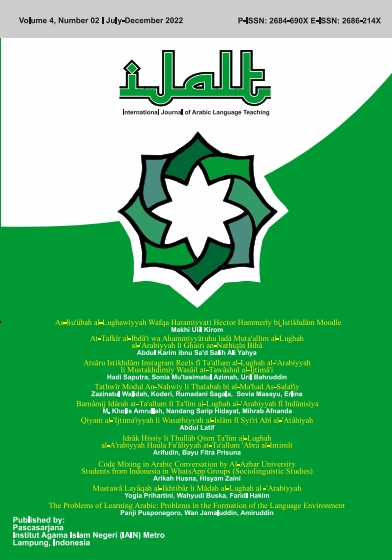Qiyâm al-‘Ijtimâ’iyyah fî Syi’r Abî al-‘Atâhiyyah
DOI:
https://doi.org/10.32332/ijalt.v4i02.5598Keywords:
ascetical; social values; tolerance.Abstract
Abu al-‘Atahiyah was famous for his ascetical poetry, but the researcher found that in Abu al-‘Atahiyah’s anthology, not all of his poems go with the ascetical theme’s only. Rather, there are also life values, such as social values that establish other human foundations that spread bonds of mercy, love, tolerance, kindness, cooperation, observance of conscience, fear of God and other meanings. The parameters of the human formulation of society are defined in the Islamic conception. The theory used in this research is the theory of life values by Noeng Muhadjir. The approach used in this research is the pragmatic approach. This approach prove that a literature work is a tool to achieve the aims of the creator of literature works, in addition to pleasure or entertainment also for the sake of enlightenment and education. This research found there are sixteen social values, and these social values show that Abu al-‘Atahiyah, who is known as a religious poet, is also a poet who pays attention to social life.
References
الإسكنداري ومصطفى عناني، الوسيط في الأدب العربي وتاريخه، (القاهرة: مطبعة المعارف،1916).
أنيس المقدسي، أمراء الشعر العربي في العصر العباسي، طبعة 17(بييروت، دار العلم للملايين، 1989).
محمد محمد داود، العربية وعلم اللغة الحديث، (القاهرة: دار غريب، 2001).
كريم زكي حسام الدين، القرابة: دراسة أنثرولغوية لألفاظ وعلاقات القرابة في الثقافة العربية، (القاهرة: مكتبة الأنجلو المصرية، 1990).
كمال محمد بشر، علم اللغة الإجتماعي، (القاهرة: دار غريب، 1997).
Al-Akkawi, Al-Mujaz fi al-Adab al-‘Arabi, (Yogyakarta: Horizon Press, 1392 H).
Beeston, A.F.L. et.al..Arabic Literature to the End of the Umayad Period. )Cambridge: Cambridge University Press, 1983).
M.Rodhi Al-Hafid, Nilai Edukatif Kisah dalam Alquran. Disertasi. (Yogyakarta: UIN Sunan Kalijaga, 1985).
H. UnaKartawisastra, Strategi Klarifikasi Nilai, (Jakarta:P3G Depdikbud, 1980).
https://fikercenter.com/studies/الوسطية-والإعتدال.
M.Chabib Thoha, Kapita Selekta Pendidikan Islam, (Yogyakarta:PustakaPelajar,Cet.I,1996).
Mansur Isna, Diskursus Pendidikan Islam,(Yogyakarta:Global Pustaka Utama, 2001).
M.H.Abrams,The Mirror and the Lamp: Romantic Theory and the Critical Tradition, (Oxford: Oxford University Press, 1980).
Surjono Sukanto, Kamus Sosiologi. (Jakarta:Rajawali Press, 1985).
Sugihastuti dan Itsna Hadi Saptiawan, Gender dan Inferioritas Perempuan. Cet II (Yogyakarta: Pustaka Pelajar, 2010).
Syamsul Maarif, Revitalisasi Pendidikan Islam,(Yogyakarta: Graha Ilmu, 2007).
W.J.S.Purwadaminta, Kamus Umum bahasa Indonesia (Jakarta;Balai Pustaka,1999).
Yunus Ali Mudhar & Bey Arifin, Sejarah Kesustraan Arab, (Surabaya: PT.BinaIlmu, 1983).









